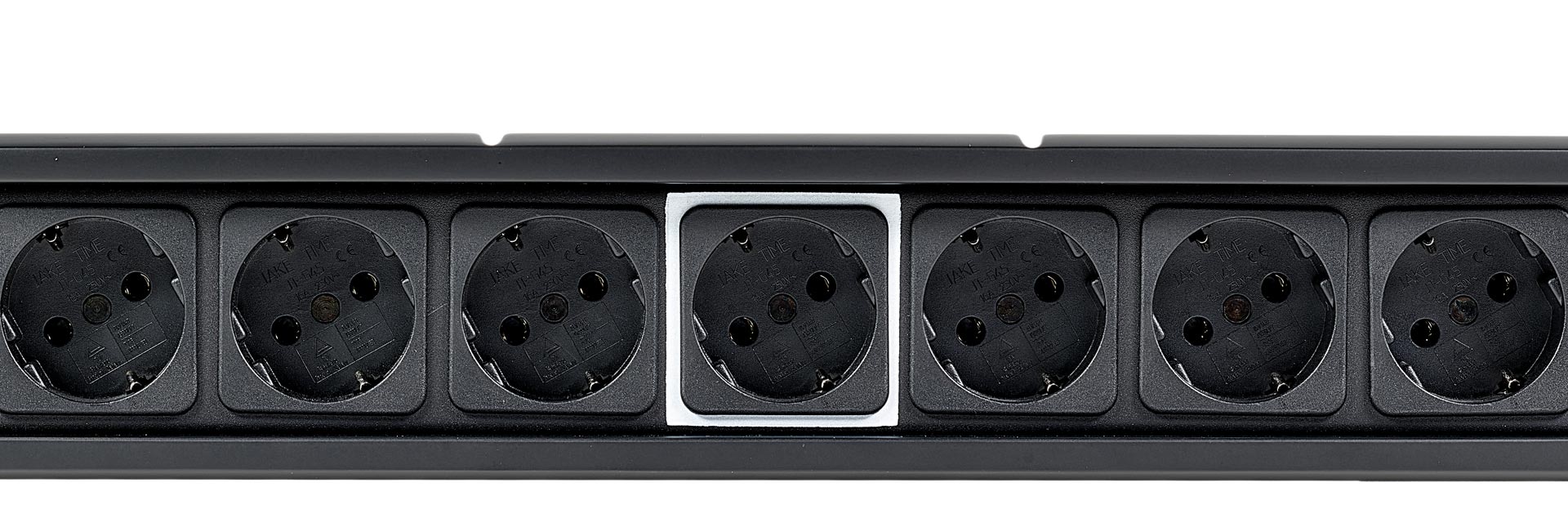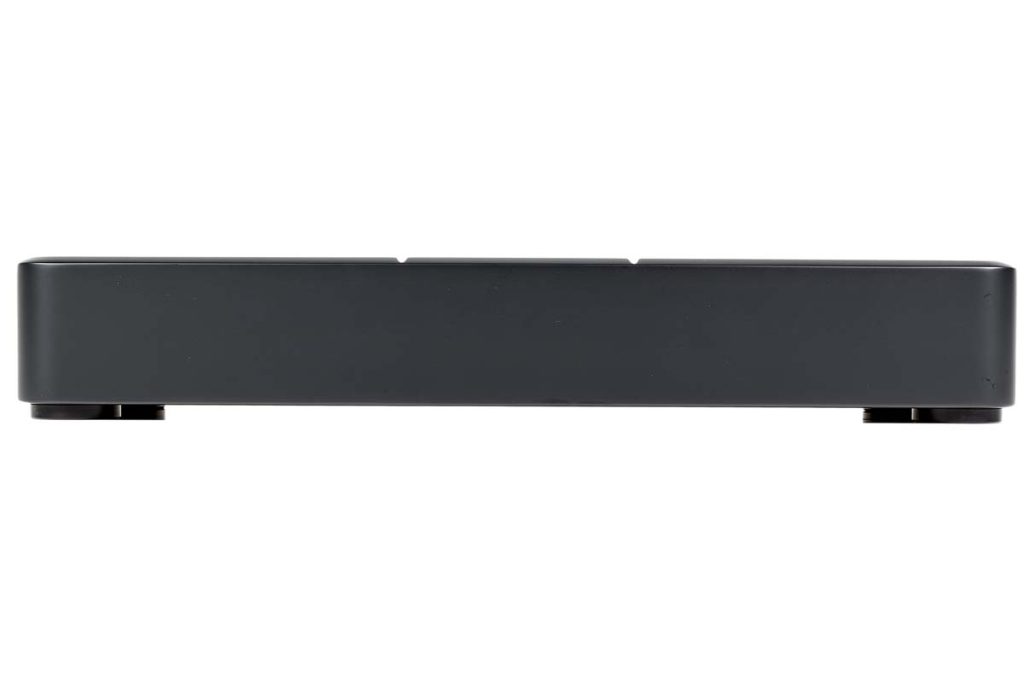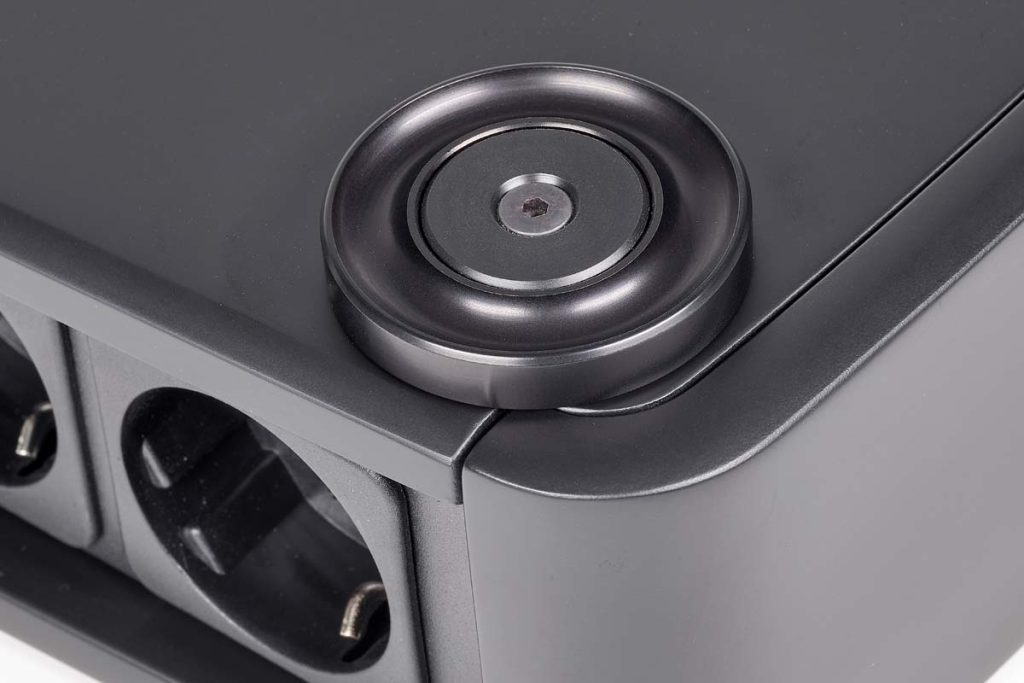It takes courage to look at things from a totally new perspective and truly do your own thing.
Ansuz has this extremely rare quality, and the power distributors of the Mainz8 series are a perfect example of the products generated by the company’s brilliant minds. Instead of filtering, suppressing or circumventing, they give the signals every possible latitude in order to incorporate more information in the chain.
It is now widely accepted that a clean voltage supply enhances the resulting sound. Even the most skeptical among us must have realized this by now. The only apology I would accept from people with contradictory views is that they are totally ignorant of clean power’s remarkable difference. Given how filter strips can readily show their qualities at trade fairs and retailer events – due to the prevalent conditions there – this would be a little surprising. Unlike amplifiers and sources, these devices easily demonstrate their potential for large audiences. Despite this, one significant obstacle remains for the clean power branch: people are usually more inclined to add yet another 43-cm appliance to their collection. When faced with choosing between a more powerful amplifier, a streamer boasting more features and formats or trying to improve small details via power tuning, the decision normally favors new components.
Ansuz’s exclusive power strips cleverly keep well away from these discussions. The Danish manufacturer stresses that their products should only be considered when potential buyers are completely satisfied with all other aspects of their hi-fi systems. But anyone who has actually experienced the effect that power distributors can have on a functioning chain will probably place it somewhere between enlightenment and being hit by an express train. At the very least, witnesses will see the issue of “power” with completely different eyes. In particular, when they realize that the Mainz8 A2 isn’t even the top-of-the-range.

Procrastination comes from the Latin “procrastinare” (meaning to ‘move forward to the next day’). It is mainly used in a pejorative sense to express unnecessarily postponing things, as is reflected in the well-known saying “procrastination is the thief of time”. It is also the word that came to mind when explaining to my increasingly irritated colleagues, for five or six days in a row, why I hadn’t finished testing the power distributor, and why I still needed to look at one final, critical aspect. My real reason for the increasingly abstruse excuses was a vain attempt to gain more time – time in which I would hopefully come to terms with my audiophile conscience.
To explain all this, let’s go back six weeks earlier … I placed the Mainz8 A2 carefully in the trunk of my car and took it home. This is not something I would normally do. As someone who hates looking at tangled cables behind racks, I always stow everything neatly behind a cabinet. However, this means that switching power strips can be more laborious than usual. On the other hand, extensive accessories testing in the FIDELITY listening room also brings its own difficulties. Things are being added and removed every day, and colleagues are permanently tinkering with equipment. In essence, it is practically impossible to create a reference configuration that remains intact for more than a few days. But before I can enjoy recabling at home, I have a completely different problem to solve. The A2 demands instant respect: not only because of its black, Darth Vader-like appearance, but also due to its weight and impressive dimensions (49 cm in width). A power component of this size requires its own space in the rack, so I first have to switch around my other components.
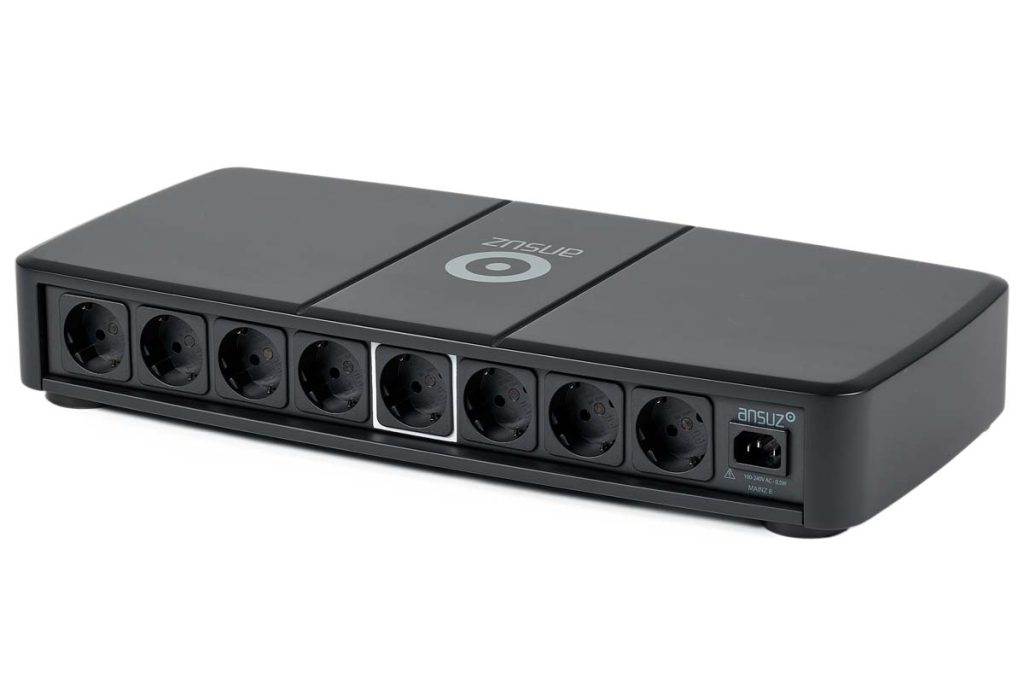
Ansuz sensibly arranges the eight rear sockets at a slight angle so that all of the outlets can be used for chunky “wall warts” or angled connectors. I connect up two active Lyravox Karlos speakers, a Lumin X1, a Clearaudio Innovation Compact (plus external power supply and Balance V2) and an Audiodata Music Server MS II that is separated from the other components using the Keces P3. I need only a couple of minutes to fill seven of the eight sockets due to my TV’s breakout box also being located in the rack. I pay little attention to the arrangement of the rear sockets until I notice that one central outlet has a white border. As I discovered later on, this white outlet is the star ground with the lowest impedance, and it is meant to accommodate the preamplifier in which all of the LF signals also meet. The socket hierarchy cascades down to the left and right sides to reflect the growing distance from the star ground. Ideally, the outer outlets feed your power amplifiers where the signal chain ends. Of course, I can’t check all of this with my two active speakers, combining preamp, DAC and power amp. However, a later test with a pre-/power amp combination from WestminsterLab slightly increased lightness and transparency, indicating that there’s some substance to the manufacturer’s claim.
In all honesty, until a few weeks ago, I took an extremely pragmatic approach to power issues. Connecting every component in phase is naturally essential. I’ve stuck a red dot to the “hot” side of practically every power outlet in my apartment, which simplifies things. Otherwise, I rely on solid, no-frills power strips. These include, in addition to Audioplan’s PowerStar S, a power strip from Fisch Audiotechnik, as well as several HMS Energia strips, to which my small home studio is attached. The P3 filter mentioned above is only temporary. Whenever an “investment” is necessary, I tend toward components that I think will enhance my system functionality – a mindset I’ve already touched on. Based on my previous experiences with my reliable power distributors, I assumed that the Ansuz unit would bring slight to (hopefully) noticeable improvements that could be seen to slightly enhance my hi-fi chain. In fact, once I had switched on the power, I was confronted with what sounded like an entirely different system.
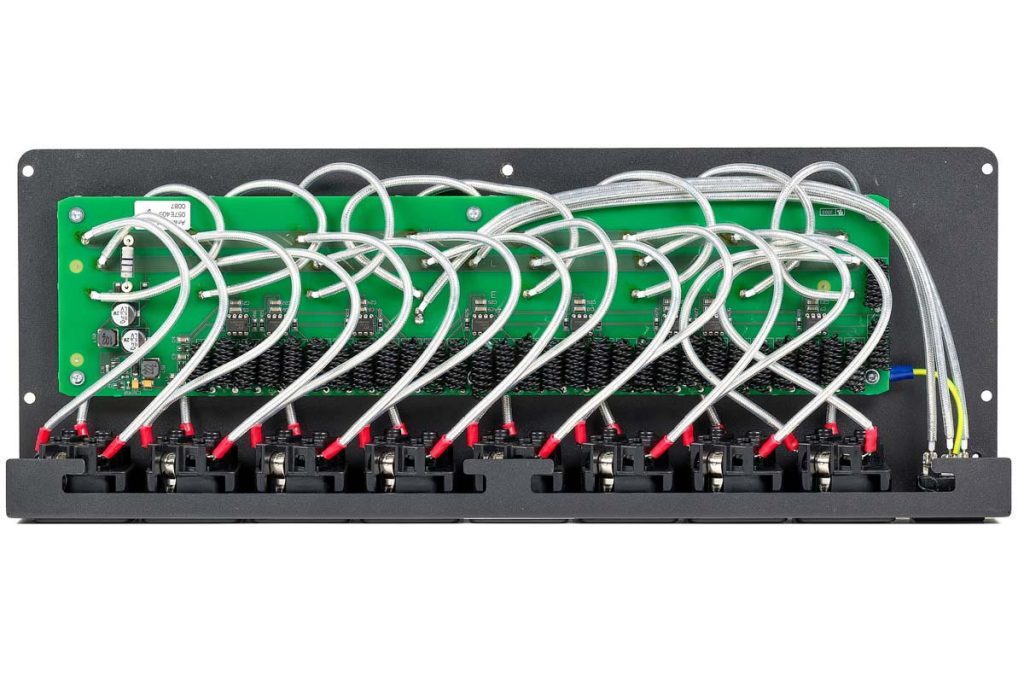
On impulse, I began my listening tests with the 2nd movement (Allegretto) from Beethoven’s 7th Symphony (DG, Kleiber). As soon as I heard the – not particularly loud – opening chord, I realized the sound was moving into entirely new dimensions. You’re probably familiar with that split-second in which you notice that something has changed dramatically, thus instantly forcing you to stop lounging in your armchair and sit up straight. The walls of the room might as well have been removed, giving the orchestra a seemingly endless space, filling the room and piercing the very fibers of my body. The whispering strings oozed out rhythmically from the speakers, building slowly, but with such haunting emotion that I experienced the first climax after two minutes along with a sense of relief. Without listening to the Allegretto in its entirety, I switched to “Apnée”, the first track on Hante’s latest album, Morning Tsunami. It begins with a thunderous and sustained “ktssSS-BOOom”, emerging with that incredible depth from the bass diaphragms, yet also a stability that I’d never experienced before. The effect floated and surged effortlessly through the room several times before fading into virtually infinite spheres. This was followed shortly after by the transition into a web of pads and basses. The abrupt break has always seemed a little diluted and blurred, with the instruments needing time to disentangle from each other. This time it sounded similar, but the players seemed to have a greater sense of order, unraveling the frequencies to such an extent that individual voices were distinguishable, and I for the first time I actually perceived an arrangement in the overall panorama.
Within five minutes of starting my listening tests, it had already dawned on me that I would have a real problem after completing them. Don’t get me wrong: I was already more than satisfied with my current configuration. My components liaised with one another superbly. They seemed to really rollick in making music together. And, admittedly, I had expected a superb power distributer to add a “certain something”. But I would have scorned the idea that it could raise my chain to completely new levels in almost every possible sense, be it spatial reproduction, release, precision dynamics or the raw stability of the lowest bass impulses. And all of this in addition to another compounding factor I’ve already alluded to: this rather exclusive A2 – the subject of our test – is essentially only a mid-range article in the portfolio of its Danish manufacturer.
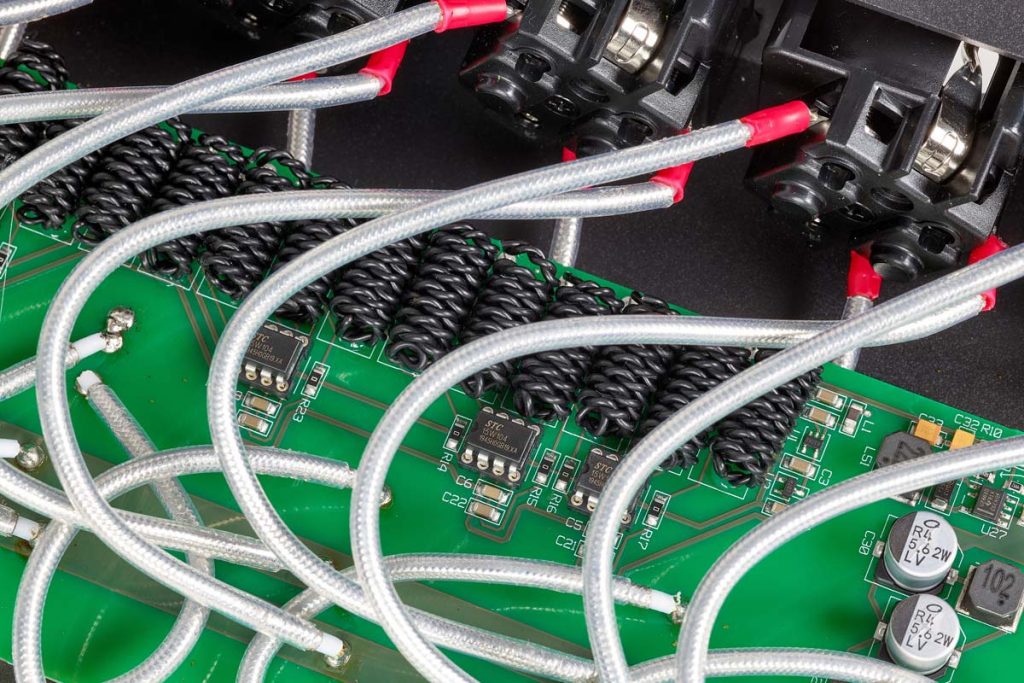
The creator of the Mainz8 is likely unsurprised by my findings. When speaking to Michael Børresen, you quickly get the sense that you’re transitioning to a different plane. He seems to regard power, music and entire hi-fi systems as nothing more than combinations of vibrations and resonances – that he can work with like any other tool. Much like a composer, he assembles his instruments (materials, power cables, etc.) so that the frequencies involved combine to create a harmonic whole. Annoying resonances – always trying to step out of line – must be terminated just like any interactions (particularly electromagnetic phenomena) that could side-swipe the vibrations in an undesirable way. This births an entire family of symphonic structures that help everything play at the right time and to just the right degree. It may all sound completely crazy, but I can’t think of any other concise way to describe the Mainz8. On paper, the black strip does nothing other than pass power from the input socket through to eight potential connected devices. Ansuz doesn’t attempt any filtering, buffering, power conditioning or resynthesizing of the mains sine.
The A2’s enclosure is made of vanished wood layers (lid and front) with a thin aluminum insert for the base and rear. It stands on four aluminum feet reminiscent of the manufacturer’s Darkz series. Inside – likewise on Darkz-type bases – a large circuit board lives alongside surprisingly few components and some conductor tracks. Rather than being soldered directly, the rear outlets are connected to the main PCB through numerous short distribution veins with different thicknesses. All of the cables are twisted together or even encased in thinner twined wires. Each delicate production step takes place directly on site in Aalborg. Unwelcome mechanical vibrations are dissipated via the superb feet, with practically no magnetic parts in the entire design. Consequently, electromagnetic fields have few potential gateways to mount an attack. The lack of direct contact between the components makes a key contribution, too – there is resonance termination both outside and inside the enclosure.
The Danish manufacturer prizes ground routing. It establishes the connection between the various players, thereby creating a common electrical point of reference for every device involved, as Børresen points out at every opportunity. That’s why the goal must be to securely connect the supported audio devices to their reference point (i.e., the device plugged into the white socket), thus avoiding any interference. The next aspect, and perhaps the most exciting one, is noise suppression. The Mainz8’s enclosure plays only a minor role here. Instead, Ansuz relies on the technical coupling of analog dither and active Tesla coils. During the dithering process, an extremely low noise is created that helps modulate the Tesla coil power. Consequently, the entire signal has minimal fluctuations along the time axis. According to Børresen, this technique permits the signal-processing devices to reproduce signal components normally hidden by background noise. Just imagine – you’re looking through a lattice fence that only permits you to see a portion of the area behind it. Seeing the entire picture requires continuously moving your head back and forth. Instead of restricting the signal conductor using filtering or massive shielding, Ansuz prefers to design its products so that they adhere to the company’s own frequency and resonance theories. This ensures that background noise and interference can’t impact the reproduction.
The combined effect of all of these unique and unconventional technologies is simply overwhelming. And it’s still only one part of the overall strategy. On a visit to Denmark, we experienced the A2 in combination with matching A2 power cables, which brought an even further noticeable improvement to the one already described. Because any unused sockets open up potential interference, Ansuz also offers terminating plugs called “Sparkz Harmonizers” that similarly feature Tesla coils and dithering. We should also mention the LF signal conductors that transport all of the above enhancements into the audio signal path, and generate a noticeable effect as well. Together, these many facets turn the Mainz8 A2 into the solid foundation for a work of art you can continually refine. And we haven’t even discussed the other much more exclusive models of the Mainz8 that the Danish manufacturers have in their locker – the C2, D2, D TC and truly superb D TC SUPREME.
Accompanying Equipment
Sources: Silent Angel Rhein, Audiodata MusikServer MS II | CD player: Ayon CD-3sx | Network player/Preamplifier: Cambridge Audio Edge NQ, Auralic Altair | Turntable: Clearaudio Innovation Basic, Audio Note TT-Two Deluxe | Loudspeakers: Lyravox Karlos, Wilson Audio Sasha DAW, Audio Note AN-J | Cables: AudioQuest, in-akustik, Chord Company, Vovox | Rack: Creaktiv, Solidsteel Captions
Power distributor
Ansuz Mainz8 A2
Concept: unfiltered power distributor with 6 outlets | Special features: analog dithering, Tesla coils and “direct grounding” technology; enclosure and other materials are completely non-magnetic | Dimensions (W/H/D): 50/8/24 cm | Weight: 5.5 kg | Warranty period: 2 years | Price: approx. € 3500
Ansuz Acoustics
Rebslagervej 4
9000 Aalborg
Denmark
Phone: +45 40 223102

